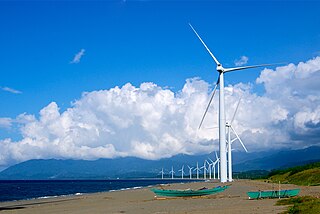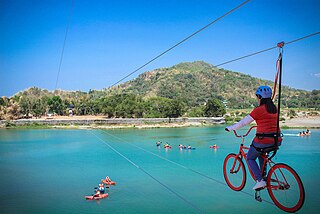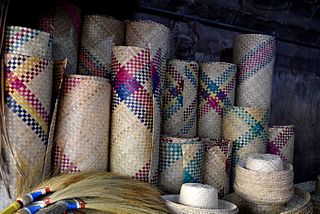
Abacá (Spanish), Musa textilis, is a species of banana endemic to the Philippines. The plant grows to 13–22 feet (4.0–6.7 m), and averages about 12 feet (3.7 m). The plant, also known as Manila hemp, has great economic importance, being harvested for its fiber, also called Manila hemp, extracted from the leaf-stems.

Ilocos Norte, officially the Province of Ilocos Norte, is a province of the Philippines located in the Ilocos Region. It is located in the northwest corner of Luzon Island, bordering Cagayan and Apayao to the east, and Abra to the southeast, and Ilocos Sur to the southwest. Ilocos Norte faces the South China Sea to the west and the Luzon Strait to the north. Its capital is Laoag City, which is the most populous in the province.

Ilocos Sur, officially the Province of Ilocos Sur, is a province in the Philippines located in the Ilocos Region in Luzon. Located on the mouth of the Mestizo River is the capital of Vigan while Candon is the most-populous city. Ilocos Sur is bordered by Ilocos Norte and Abra to the north, Mountain Province to the east, La Union and Benguet to the south and the South China Sea to the west.

La Union, officially the Province of La Union, is a coastal province in the Philippines situated in the Ilocos Region on the island of Luzon. The province's capital, the City of San Fernando, is the most populous city in La Union and serves as the regional center of the Ilocos Region.

The Cordillera Administrative Region, also known as the Cordillera Region and Cordillera, is an administrative region in the Philippines, situated within the island of Luzon. It is the only landlocked region in the archipelago, bordered by the Ilocos Region to the west and southwest, and by the Cagayan Valley Region to the north, east, and southeast.

The Ilocos Region, designated as Region I, is an administrative region of the Philippines. Located in the northwestern section of Luzon, it is bordered by the Cordillera Administrative Region to the east, the Cagayan Valley to the northeast and southeast, Central Luzon to the south, and the South China Sea to the west.

Vigan, officially the City of Vigan, is a 4th class component city and capital of the province of Ilocos Sur, Philippines. According to the 2020 census, it has a population of 53,935 people.

Laoag, officially the City of Laoag, is a 3rd class component city and capital of the province of Ilocos Norte, Philippines. According to the 2020 census, it has a population of 111,651 people.

Bangui, officially the Municipality of Bangui, is a 4th class municipality in the province of Ilocos Norte, Philippines. According to the 2020 census, it has a population of 15,019 people.

Vintar, officially the Municipality of Vintar, is a 1st class municipality in the province of Ilocos Norte, Philippines. According to the 2020 census, it has a population of 33,339 people.

Caoayan, officially the Municipality of Caoayan, is a 4th class municipality in the province of Ilocos Sur, Philippines. According to the 2020 census, it has a population of 19,574 people.

Galimuyod, officially the Municipality of Galimuyod, is a 4th class municipality in the province of Ilocos Sur, Philippines. According to the 2020 census, it has a population of 10,244 people.

Sinait, officially the Municipality of Sinait, is a 3rd class municipality in the province of Ilocos Sur, Philippines. According to the 2020 census, it has a population of 25,998 people.

San Jacinto, officially the Municipality of San Jacinto, is a 3rd class municipality in the province of Pangasinan, Philippines. According to the 2020 census, it has a population of 44,351 people.

The Ilocanos, also referred to as Ilokano or Iloko, are an Austronesian ethnic group and the third-largest ethnolinguistic group in the Philippines. Originally from the Ilocos Region on the northwestern coast of Luzon, Philippines and later expanded throughout Northern Luzon. Their native language is called Iloco.

A baníg is a traditional handwoven mat of the Philippines predominantly used as a sleeping mat or a floor mat. Depending on the region of the Philippines, the mat is made of buri (palm), pandanus or reed leaves. The leaves are dried, usually dyed, then cut into strips and woven into mats, which may be plain or intricate.
The arts in the Philippines reflect a range of artistic influences on the country's culture, including indigenous art. Philippine art consists of two branches: traditional and non-traditional art. Each branch is divided into categories and subcategories.

Tnalak, is a weaving tradition using resist-dyed threads of the Tboli people of South Cotabato, Philippines. T'nalak cloth is woven exclusively by women who have received the designs for the weave in their dreams, which they believe are a gift from Fu Dalu, the T'boli Goddess of abacá.

The World Costume Festival is an international fashion festival held every two years in the Philippines city of Vigan City in Ilocos Sur. The event showcases indigenous and modern costumes geared towards live performances, such as drama, festivals, events, as well as multimedia presentations. It emphasizes apparel for special ritual occasions or theater performance work as opposed to regular fashion apparel. Its organizers aim to promote tourism as well as encourage native loom-weaving and fabrics. There is an emphasis on fabric materials and Philippine weaving methods such as batik, abel, and piña, from different parts of the Philippines. A festival was held in Vigan City in the last week of April in 2013. The dominant view is that the 2013 festival in Vigan was the first world costume festival, although there is a report of a similar costume festival that was held in Davao City in the southern Philippine island of Mindanao in 2001. There are reports of the event either becoming an annual event or being held every two years. The event coincides with fashion festivals held in different cities in the Philippines. The event was described as a preview for the World Stage Design Festival in Cardiff, Wales. The primary focus of the event is a costume competition. The highest award at the festival is the Golden Kneeling Carabao Trophy, the carabao is a Philippine water buffalo sometimes found in swamps. In addition to the costume competition, the event has workshops, classes by designers, conferences, as well as lectures from international experts. There is a costume parade down the cobblestone streets of Vigan. The event has "jubilant colors" as well as a body-painting competition. The Manila Standard described the event as "kaleidoscopic" with people wearing costumes from the historic past.

Magdalena Gamayo is a Filipino weaver who is a lead-practitioner of the Ilocano tradition of pinagabel.



















